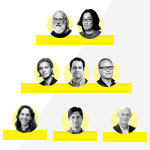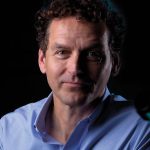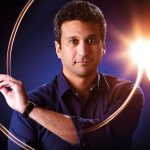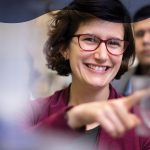OBSERVATIONS Eiman Azim Decoding dexterity
Humans can move their bodies to do incredible things. Some can play concertos or hit home runs, but for the rest of us, even everyday movements such as buttoning a shirt or typing an email are acts of astonishing complexity. We need to coordinate the contraction of dozens of muscles with precision to accomplish these dexterous tasks, yet scientists still do not have a clear understanding of how the nervous system is able to orchestrate such complex behaviors.
Inside Salk chatted with Azim to learn about his thoughts on what’s next in neuroscience, how all scientists are philosophers and what he learned about movement from observing his newborn.
Eiman Azim, assistant professor in the Molecular Neurobiology Laboratory and the William Scandling Developmental Chair, seeks to uncover how the brain and spinal cord control dexterous movement of the arms, hands and fingers. By using sophisticated molecular genetic tools, his lab is uncovering how circuits in the nervous system work together to create movement, and how the function of these pathways is affected by neurodegenerative disease and injury.
What big questions are you trying to answer in science?
We’re trying to understand how the brain controls behavior. Asking these types of questions is like trying to solve a large puzzle where we have to figure out how all the pieces fit together, often without even knowing what all the pieces are. And not just how they fit together in a static picture, but how they dynamically change with time as well. For example, as you reach down to tie your shoe, how does the communication of different neural circuits change to coordinate behaviors? If you stumble, how do the circuits respond so you don’t fall?
My lab tries to gain insight on how the brain processes signals to produce a desired outcome, and what goes wrong in conditions that affect movement, such as Parkinson’s disease and amyotrophic lateral sclerosis (ALS). I believe that if we want to develop better approaches to diagnose and treat disease and injury, we need a much better understanding of how the normal system fundamentally operates.
Neuroscience is an established field. Why do scientists still know so little about how the brain controls movement?
The human brain contains nearly 100 billion neurons with a huge variety of cell subtypes, all intermingled in incredibly complex networks. Trying to disentangle these networks to decipher the function of each type of neuron is difficult. Over the past few decades, there’s been a molecular genetic revolution in neuroscience. What this means is that we can now take advantage of the fact that different types of cells, including neurons, express different genes. These diverse gene expression patterns allow us to differentiate between different types of neurons, and to use their genetic identities to access them selectively in our experiments. So, if we can decipher these molecular codes, then we can look at how these neurons connect to each other to form circuits. We can also remove specific neurons from the circuit, or turn them on or off at will, to investigate their function. Molecular genetics gives us the tools to access the brain with precision, so we can ask targeted questions about each type of neuron’s contribution to movement.
Do you have any exciting projects in your lab right now?
I find them all exciting! Big picture, we’re interested in learning more about how two major types of pathways interact to control movement. The first is the chain of events that sends commands from your brain down to your spinal cord, and ultimately out to your muscles to move. The second pathway involves all of the feedback from your body (such as your skin and your muscles) that gets sent back into your spinal cord and brain to report the consequences of the movement. These command and sensory pathways are constantly interacting in a dynamic way, and we are trying to define how these interactions take place and why they are needed for dexterity.
One of the specific projects in my lab right now is examining how to control the strength of the sensory feedback transmitted to the brain. Our bodies are bombarded with stimuli that activate sensory receptors. Much of this sensory information is distracting or noisy, suggesting that we need a way to “turn down” some of these signals, while allowing the important signals to make it into the brain. We’ve been identifying circuits in the brain that can adjust the strength of tactile signals that come from our skin, a process that appears to be critical for effectively grasping and manipulating objects to interact with the world.
Growing up, did you always know you wanted to become a neuroscientist?
I have always loved science, but it really wasn’t until college that I fell in love with neuroscience. When I was at Stanford University as an undergraduate, I was passionate about philosophy, specifically philosophy of mind. As I dove deeper into the subject, I became fascinated with the questions, which were grand, but a bit frustrated with our inability to come up with definitive answers.
And so that’s when I decided to enter laboratory science to perform experiments and collect data on accessible problems in the brain that could eventually shine some light on these larger questions about the human condition.
Do you think your background in philosophy informed your current career in research?
I do. I think philosophy teaches us how to think about a problem. We’re all philosophers; scientists gain their training by earning a doctorate in philosophy. The life sciences have long been a branch of philosophy, where we look at the world, are curious about a problem, and try to come up with rational and intelligent ways to address that problem.
What brought you to Salk and what keeps you here?
The Salk Institute is different than any other institution I was considering. It’s small by design and incredibly collaborative. There are no departments and very few barriers or boundaries between disciplines. When you’re walking through the beautiful campus, you run into some of the best scientists in the world. For example, I might have coffee with a plant biologist one day and a cancer scientist the next. That doesn’t happen quite as easily at big universities.
What are some of your favorite things to do outside of work?
I play the guitar. I really enjoyed playing in a band in college, and I recorded an album while I was doing my postdoctoral fellowship in New York. I have yet to find the time or the bandmates here in San Diego, so it’s on the back burner for now. One of the reasons time is scarce is that my wife and I recently had our first child, which has been pretty incredible.
What is it like having a baby while being a full-time research scientist?
I’m still figuring that out, but it’s a balancing act. Before having my son, my friend gave me the following advice: “You basically have to get the same amount done in a lot less time.” And he was not wrong. So, I’ve tried to cut out a lot of the extraneous stuff in my life to better focus on the science when I’m at work, and my son while I’m at home.
Is sleep considered extraneous?
Often.
Since you study how the nervous system controls movement, are you excited to watch your son reach developmental milestones such as crawling and walking?
Oh, absolutely. It’s been fascinating. When he rolled for the first time, it was just amazing to watch. Babies are experimentalists; they try something and then it works or produces an outcome, and they do it again and again to confirm that it’s true. And if something fails, they’ll go and try something new. These are good lessons for the lab.
What do you think the future holds for understanding the neural basis of movement?
We’re at a fascinating and fast-changing moment in neuroscience. The field of movement research is already gaining insights that are telling us how our nervous system might be working, and also showing us what might go wrong in disease and injury. For example, the development of prosthetics that receive signals from and send signals to the brain is moving at an incredible pace, helping people that have lost motor function. The way we can continue to develop advanced technologies like these is by using the lessons we’ve learned in basic science laboratories, and for scientists to continue to learn lessons from the patients who can benefit. This two-way communication between experiments in the lab and patients in the clinic inspires me every day.
Support a legacy where cures begin.
Featured Stories
 Apart but togetherAs COVID-19 spreads across the world, organizations like the Salk Institute have mobilized to respond. In this feature article, read about how the Institute is adapting and continuing its groundbreaking science.
Apart but togetherAs COVID-19 spreads across the world, organizations like the Salk Institute have mobilized to respond. In this feature article, read about how the Institute is adapting and continuing its groundbreaking science. New COVID-19 research projectsIn addition to Salk’s ongoing research areas relevant to COVID-19, several new coronavirus-specific projects have recently launched. These innovative projects range from understanding the structure of the virus to mobilizing the body’s immune reaction.
New COVID-19 research projectsIn addition to Salk’s ongoing research areas relevant to COVID-19, several new coronavirus-specific projects have recently launched. These innovative projects range from understanding the structure of the virus to mobilizing the body’s immune reaction.
 A conversation with Martin HetzerIn the last few months, Salk Vice President and Chief Science Officer Martin Hetzer spearheaded the Institute’s efforts to respond to the pandemic from both an administrative as well as a scientific perspective.
A conversation with Martin HetzerIn the last few months, Salk Vice President and Chief Science Officer Martin Hetzer spearheaded the Institute’s efforts to respond to the pandemic from both an administrative as well as a scientific perspective.
 Eiman Azim – Decoding dexterityIn this Q&A, Assistant Professor Eiman Azim shares his thoughts on what’s next in neuroscience, how all scientists are philosophers and what he learned about movement from observing his newborn.
Eiman Azim – Decoding dexterityIn this Q&A, Assistant Professor Eiman Azim shares his thoughts on what’s next in neuroscience, how all scientists are philosophers and what he learned about movement from observing his newborn.
 Nasun Hah – Next gen sequencingAs the director of the Next Generation Sequencing Core, Staff Scientist Nasun Hah collaborates with everyone from plant biologists to neuroscientists to provide support and information about sequencing genes and entire genomes.
Nasun Hah – Next gen sequencingAs the director of the Next Generation Sequencing Core, Staff Scientist Nasun Hah collaborates with everyone from plant biologists to neuroscientists to provide support and information about sequencing genes and entire genomes. Update on initiatives to support diversity and BIPOCLearn about the Institute’s commitment to and actions around diversity and inclusion.
Update on initiatives to support diversity and BIPOCLearn about the Institute’s commitment to and actions around diversity and inclusion. Molly MattyMolly Matty, a postdoctoral researcher in the lab of Associate Professor Shrek Chalasani, shares what worms can teach us about human behavior, why science outreach is so important and why she enjoys puns.
Molly MattyMolly Matty, a postdoctoral researcher in the lab of Associate Professor Shrek Chalasani, shares what worms can teach us about human behavior, why science outreach is so important and why she enjoys puns.



















































